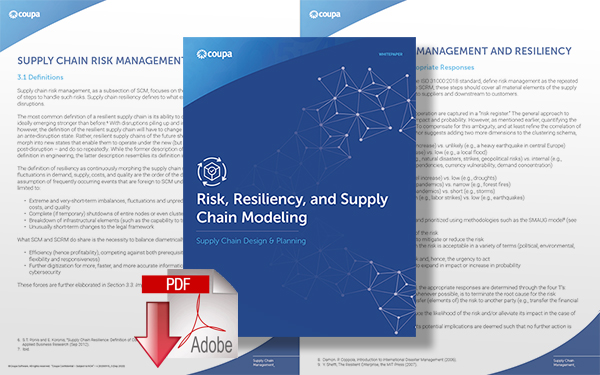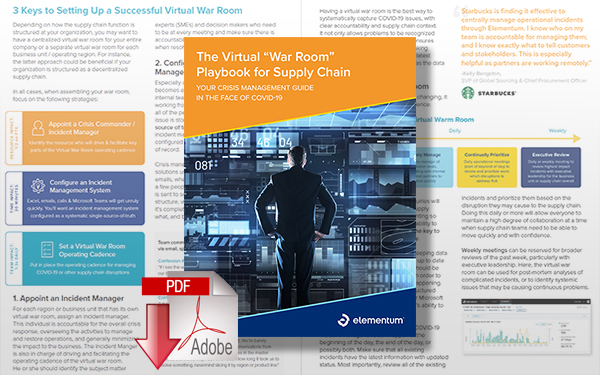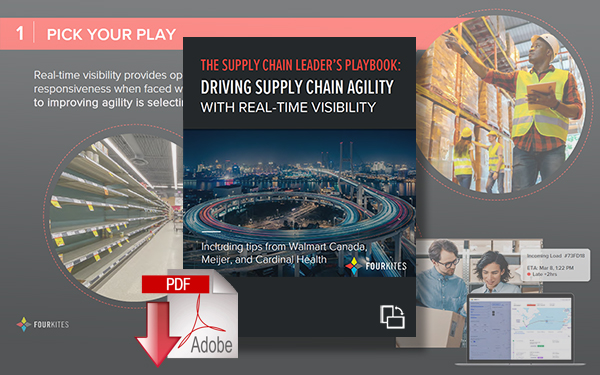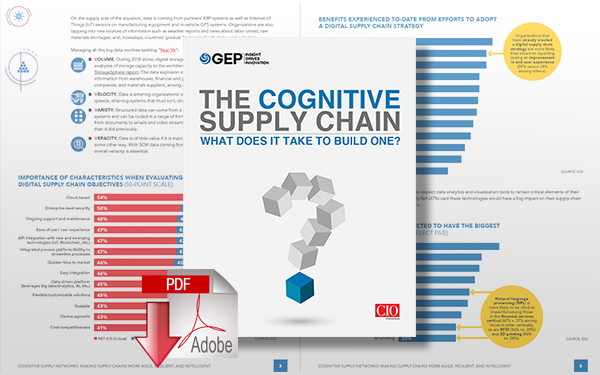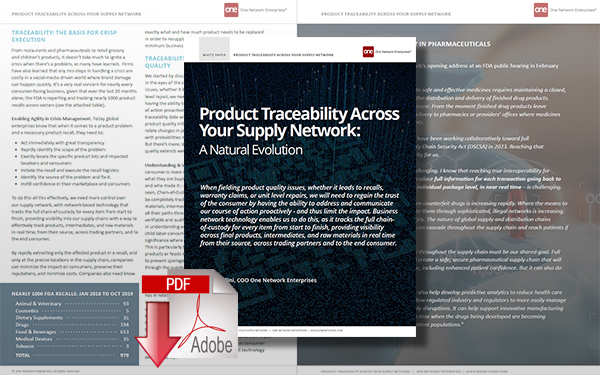How the Global Pandemic Accelerated Supply Chain Visibility, Digitalization, and Automation

The COVID-19 pandemic has challenged how companies look to digital technologies to provide greater supply chain visibility and automation into providing shippers with real-time views of their end-to-end global networks.
The Digital Supply Chain
The many different facets of the digital supply chain have been moving into position for years.
Then, when the global pandemic emerged, it effectively pushed the final pieces of that puzzle into place - and faster than anyone could have ever imagined.
Yossi Sheffi, Ph.D., an MIT professor, and director of the university’s Center for Transportation and Logistics, says;
“Clearly, the pandemic pushed companies to use more digital tools to run their supply chains.”
As companies began looking for more digital technology to solve their pain points, Sheffi says visibility became a key focus - and a good entry point for solutions focused on giving shippers real-time views of their end-to-end supply networks.
Bart De Muynck, research vice president, transportation technology at Gartner concurs and says he has seen a significant uptick in interest in digital supply chains over the last year to 18 months.
Any company that was previously using a combination of analog (e.g., spreadsheets and clipboards) and digital (software, Cloud, AI) processes to run their supply chains quickly stepped up their investment in the latter to offset the business impacts of the global pandemic.
“The focus is no longer on how to create a digital business model, it’s on how to fully execute on digital,” says De Muynck, who sees this focus continuing over the next 6 months to 12 months as companies realign and recover.
“The disruption we’ve seen over the last 18 months has completely accelerated the interest in creating digital business models.”
New Supply Chain-Related Products
As new supply chain-related software, equipment, devices, and applications hit the market, shippers across all industries have been testing those solutions out and folding them into their own supply chain strategies.
As their digital supply chain slowly began taking shape, companies started applying machine learning, automation, AI, the Internet of Things (IoT), the Cloud, and other advanced options to their global supply chains.
When the global pandemic emerged, the pace of change on the digital supply chain front accelerated significantly. Seemingly overnight, shippers were grappling with an entirely new set of challenges.
Companies that were using antiquated visibility and forecasting tools (e.g., those based on spreadsheets or in disconnected software systems) had difficulties keeping up with huge upticks in ecommerce orders, managing remote workforces, handling supply interruptions, and meeting brand new customers demands.
With 2020 now firmly in the rearview mirror, the technology decisions companies made over the last 12 months are making for a less tumultuous year - despite the ongoing impacts of the pandemic - while also pushing shippers to more closely examine what the digital supply chain means to them.
According to Steve Banker, vice president of supply chain management at ARC Advisory Group, much of the focus right now is on gaining better visibility over the entire supply chain, “from the supplier’s supplier to the customer’s customer.”
Put simply, visibility isn’t just about Tier 1 or Tier 2 suppliers anymore: It’s about the entire supply chain.
Banker says companies are also striving for better ability, and that they’re using what Gartner refers to as “multi-enterprise supply chain business networks,” to gain both upstream and downstream visibility into supply chain activities. As a component of digital transformation, these networks help shippers remain competitive, minimize risk, increase efficiency, reduce costs, and leverage new opportunities.
Singling out the risk category, Banker says companies are using digital supply chain solutions to “comb” online publications, social media, and other sources to identify events that might disrupt a supply chain. Software vendors have stepped up to the plate in this area, he adds, and have joined numerous companies in their quest to help shippers more proactively monitor and address supply chain-related issues, companies such as;
Risk, Resiliency, and Supply Chain Modeling
This paper first examines why existing supply chain management practices do not naturally develop resilient supply chains and why some of the existing supply chain processes are not suitable for addressing such risks and required responses. Download Now!
The Virtual Supply Chain “War Room” Playbook
In this playbook, we examine one best practice that leading supply chain teams are turning to as they adjust to the wide-ranging impact of the next normal for the supply chain: a virtual war room. Download Now!
Driving Supply Chain Agility with Real-Time Visibility
In this Supply Chain Leader’s Playbook, we detail how, through a constant emphasis on efficient processes and empowered employees, the agile supply chain benefits the greater organization by allowing it to act quickly and decisively in the face of disruption including tips from Walmart Canada, Meijer, and Cardinal Health. Download Now!
The Cognitive Supply Chain: What Does It Take to Build One?
In this survey, The Cognitive Supply Chain: What Does it Take to Build One?, GEP and CIO.com discuss the building blocks of an intelligent supply chain network, these are the key elements you’ll need to build a digital, cognitive supply chain that gives your business a unique competitive advantage. Download Now!
Product Traceability Across Your Supply Network
This report explains how new business network technology enables us to track the full chain of custody for every item from start to finish, providing visibility across final products, intermediates, and raw materials, and it does this in real-time, from their source, across trading partners, and to the end consumer. Download Now!
Concurrent Supply Chain Planning
Banker says that he’s also seen heightened interest in supply chain planning that’s based on concurrent planning capabilities, the latter of which factor in both upstream and downstream activities. “Through our research, we can see that vendors in the supply chain planning (SCP) space that are best known for concurrent planning grew right through COVID,” he points out.
“Concurrent planning is an end-to-end model that links to the longer-term sales and operations planning (S&OP) model,” Banker explains. The wholesale distributor that blends accurate lead times from its suppliers with its own distribution center (DC) constraints, for example, can more accurately predict how long it will take to ship a finished product to its own customers.
“Where S&OP looks at how to match supply to demand next month and the month after that,” Banker adds, “the concurrent plan senses disruptions and runs simulations to determine the cheapest way to meet customer obligations, like adding a second shift in a busy DC.”
Another digital supply chain technology that took off last year, and that continues to gain steam, is the supply chain control tower. These applications gather data from all points across the supply chain and then translate those points into actionable information. With this intelligence in hand, shippers can improve supply chain visibility and make better decisions that are rooted in real-time analytics.
In response to the COVID crisis, McKinsey says 39% of industry leaders implemented a control tower approach in order to increase end-to-end supply-chain transparency. “Control towers have been around for a while, but we’re now seeing a new generation that is much more robust than older control towers,” Banker observes;
“Right now, there appears to be a rush among big companies to put in good supply chain control towers.”
Continuing Down the Supply Chain Digital Path
From Mike McCullough’s vantage point as principal and North America supply chain lead at Capgemini, the push to roll out new and augment existing digital technologies is in full force right now.
And while pre-COVID efforts in this area revolved around lowering costs (e.g., decreasing manufacturing costs through offshoring), McCullough says the focus has since shifted to improving resilience and agility while meeting customer demands. McCullough explains;
“As supply chains spread out around the globe, it may have been good from a cost and an overall globalization perspective, but it also added a fair amount of risk to the supply chain, I don’t think people fully realized that until COVID hit.”
As they rethink and reposition their supply chain strategies, shippers are also striving for higher levels of visibility that digital supply chain technologies and control towers can provide.
In reviewing the progress made in the digital supply chain space over the last few years - both from the user perspective and in terms of the vendors supplying the solutions - McCullough says that there are still some hurdles to climb on the path to a truly digital, end-to-end supply chain. As the solutions continue to mature, he says the likely focus will be on using advanced options like machine learning to more accurately predict demand, respond to disruptions and meet customer needs.
“We’re still a bit away from having a fully touchless, automated supply chain,” says McCullough, who notes that even with the most advanced technology in place, predicting an event like the Ever Given’s Suez Canal blockage would have been difficult to foresee and prepare for. The good news is that the companies that have invested in newer, cutting-edge technologies supported by AI and other advanced options should be able to adjust on the fly and better handle this and other crises.
Shopping Tips for Shippers
If 2021 is the year that your company ramps up its investment in digital supply chain technology, Sheffi says the key is not to think in terms of the solutions themselves. Instead, carefully assess the problems that those solutions promise to solve, and then pick the options that address your organization’s biggest supply chain-related pain points.
Sheffi advises;
“Don’t think in terms of what IoT, robotics, blockchain, or automated tracking can do for you; think in terms of the problems first and then look at the technologies themselves.”
If you’re grappling with low productivity levels in a key warehouse, for instance, don’t just automatically zero in on a robotics investment.
A better approach, says Sheffi, is to come up with ways to creatively augment and support human labor in that setting. If robotics is the answer, then, by all means, explore that as a potential option. If not, then keep an open mind about other alternatives that can propel your company one step further toward the digital supply chain.
And don’t forget to include suppliers and customers in those technology selection conversations, says De Muynck, who sees more companies striving for a more collaborative approach to the digital supply chain. Not only does this help cut costs, but it also ensures a shared-risk environment, whereby all players in the network have a stake in the IT investment.
Getting more stakeholders involved in the digital supply chain also helps companies get one step closer to having 100%, end-to-end, real-time supply chain visibility. “Technology maturity is driving collaboration in this space, with Cloud-based systems allowing shippers to connect their visibility networks to their suppliers, customers and even to other shippers,” De Muynck adds, “Companies want to be able to collaborate, and the network itself is an essential part of that process.”
Related Supply Chain Visibility Content:
Improving Agility with Real-Time Supply Chain Visibility
Top Trends Accelerating Supply Chain Operations in 2021
3 Ways Artificial Intelligence/AI Can Help With Supply Chain Digital Transformation
Providing Free Virtual “War Rooms” To Supply Chain Organizations Dealing With COVID-19 Disruptions
9 Ways to Improve Supply Chain Resiliency in Response to Executive Order on America’s Supply Chains
Article Topics
Coupa News & Resources
How Microsoft Improved ESG & Sustainable Spending Working Together with Community.ai Capabilities Supply Chain Agility in an Ever-Changing World How Sourcing Can Respond in Dynamic Markets to Drive Supply Chain Value Build Resilience in Supply Chains by Modeling & Designing Multiple Demand Futures Beyond Disruptions: Building the Next Generation of Resilient Supply Chains 6 Truths About Business Spend Management Technology 5 Ways Supply Chains Can Flourish in an Inflationary World More CoupaLatest in Supply Chain
How Much Extra Will Consumers Pay for Sustainable Packaging? FedEx Announces Plans to Shut Down Four Facilities U.S. Manufacturing is Growing but Employment Not Keeping Pace The Two Most Important Factors in Last-Mile Delivery Most Companies Unprepared For Supply Chain Emergency Microsoft Unveils New AI Innovations For Warehouses Let’s Spend Five Minutes Talking About ... Malaysia More Supply ChainAbout the Author




